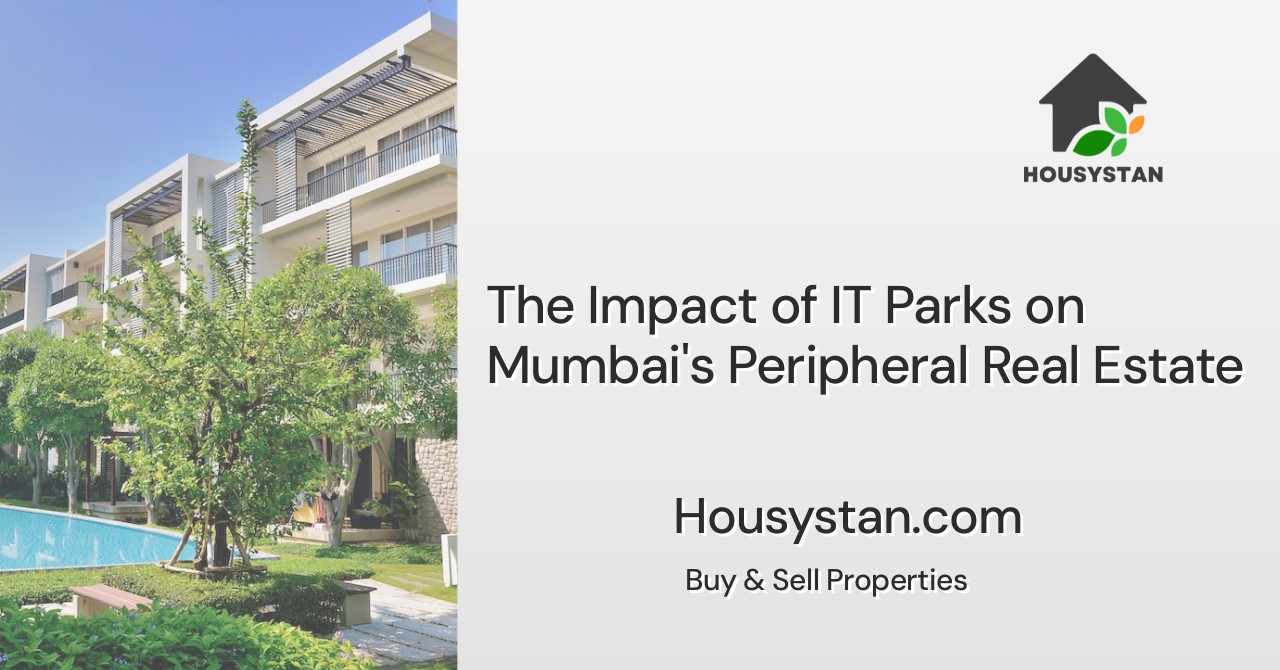The Impact of IT Parks on Mumbai's Peripheral Real Estate
Read latest blogs and articles from Housystan

The Information mentioned here was last updated on:
31/12/2025Exploring the Impact of IT Parks on Mumbai's Peripheral Real Estate
Mumbai, often dubbed as the city that never sleeps, has seen remarkable transformations in its urban and suburban landscapes over the years. A significant driver of this change has been the proliferation of Information Technology (IT) parks in and around the city. These sprawling tech campuses have not only altered the economic fabric but also significantly influenced the neighboring real estate markets. In this blog post, we will delve into how the establishment of IT parks is shaping Mumbai's peripheral real estate scene.
The Rise of IT Parks in Mumbai
- Verified Tenants/Buyers
- Unlimited Property Listing
- Zero subscription/charges fee
Information Technology has been a beacon of opportunity, leading to the development of IT parks designed to host numerous tech companies. Mumbai, as one of India's primary financial and commercial centers, has embraced this trend. Areas such as Navi Mumbai, Thane, and Powai have been focal points for the development of these technological hubs. The setup of IT parks acts as a magnet, attracting both domestic and international tech companies.
These parks provide state-of-the-art infrastructure, robust security, and reliable connectivity, making them an attractive proposition for IT businesses looking to set up or expand. Their presence boosts employment opportunities, drawing in a skilled workforce from various parts of the country. The influx of professionals inevitably creates a ripple effect on the local housing markets.
Connecting the Dots: IT Parks and Real Estate Growth
Increased Demand for Housing
The establishment of IT parks has directly contributed to rising demand in the peripheral real estate sector. As more professionals migrate to Mumbai for work, demand for housing in nearby areas surges. Developers have responded to this boom by launching various residential projects to cater to this growing population. As these professionals seek accommodations closer to their workplaces, neighborhoods like Vikhroli, Ghansoli, and Kanjurmarg have witnessed increased interest in both buying and renting properties.
Rise in Property Prices
A natural consequence of heightened demand is the appreciation of property values. The presence of an IT park can significantly upscale the land's value and surrounding properties. Homeowners and investors alike find this lucrative presence comes with attractive returns on investment, with many opting to purchase properties here as rental incomes soar.
Mixed-Use Developments
Another interesting byproduct of IT park development is the rise of mixed-use projects. Developers are increasingly incorporating residential, commercial, and recreational spaces within the same complex or vicinity. This holistic approach caters to the diverse needs of the workforce, providing seamless access to not only homes but also shopping centers, gyms, and restaurants. The convenience factor enhances the appeal of these regions, further driving up demand.
Improvement in Infrastructure
The influence of IT parks extends beyond just real estate. With the influx of professionals and the resultant population density, there is a compelling need to upgrade local infrastructure. Government and private stakeholders often collaborate to enhance roads, public transport, and utilities, thereby improving the overall quality of life for residents. This infrastructure development inadvertently boosts real estate prospects, as well-connected areas are always in high demand.
Challenges and Considerations
Urban Sprawl and Congestion
While IT parks bring prosperity and growth, they can also contribute to urban sprawl. As more people move to these peripheral areas, the risk of congestion and environmental impact increases. Urban planners and developers need to be mindful of sustainable development practices to mitigate these challenges.
Environmental Concerns
The construction of expansive IT parks and residential complexes can sometimes lead to environmental degradation. Greenfield developments—projects on previously undeveloped land—need to employ strategies that preserve the natural ecosystem and responsibly manage resources.
Balancing Work-Life Scenario
The fast-paced nature of the IT sector can lead to a skewed work-life balance for individuals, impacting community dynamics. Creating vibrant communities with access to open spaces, cultural activities, and social engagement opportunities is key to maintaining a harmonious societal fabric.
Future Prospects: A Win-Win Scenario
While challenges exist, the impact of IT parks on Mumbai's peripheral real estate presents a largely positive outlook. The continued evolution of these tech hubs is likely to unlock further value in the surrounding areas, making them attractive destinations for investment. As the city continues to expand outward, peripheral areas offer a blank canvas for innovative urban planning and sustainable growth strategies.
The blending of technological prowess with real estate development sets the stage for an exciting future, one where Mumbai can continue to cement its status as a global city. With thoughtful planning and collaboration among stakeholders, the synergy between IT parks and real estate can lead to a prosperous and sustainable urban environment.
Overall, it's a fascinating time for the real estate market on the fringes of Mumbai, with IT parks playing a pivotal role in shaping the future landscape. The transformation seen in recent years provides valuable insights into what lies ahead and invites ongoing attention to the opportunities and challenges that come with rapid urban development.